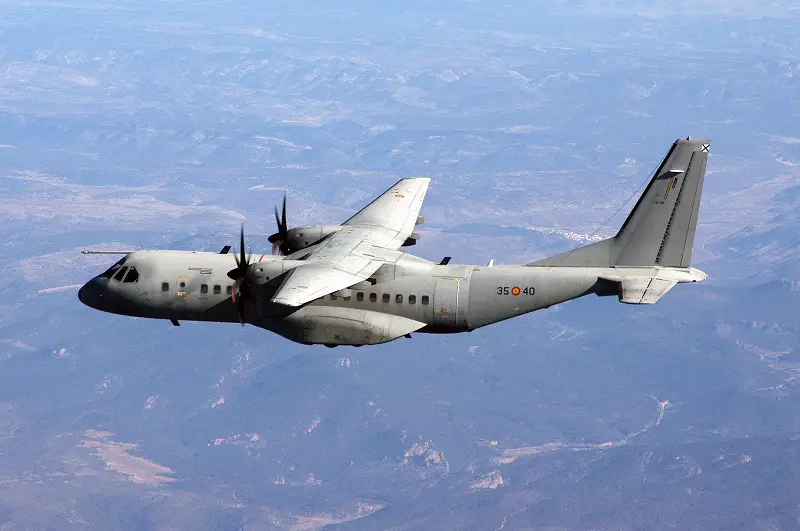Indra will renew the radar warning and self-protection controller system of the 35th Spanish Air and Space Force Wing’s entire fleet of C295 (T.21) military transport aircraft to increase their protection and capacity to carry out missions in conflict zones. This first order is part of the outline agreement that the company has reached with NATO to supply this equipment. The C295 is one of the most versatile and robust medium tactical transport aircraft available. Its role is crucial to transporting troops and materiel quickly to any point on the planet and perfectly complements the capabilities of heavy transport aircraft such as the A400M. But for such an aircraft to operate in conflict zones, it needs state-of-the-art electronic defence equipment that is always one step ahead of the surveillance and weapons systems used by the enemy.
For this reason, the Spanish Air and Space Force has entrusted Indra with the replacement of the legacy solution, which the company itself implemented in these aircraft when they entered service, with the new ALR-400, the most advanced and modern version developed by the technology company. This is also the same system already used by the rest of the Spanish Ministry of Defence transport aircraft and fighters, with the sole exception of the Eurofighter, which is equipped with the DASS Praetorian, in whose development Indra also participated. The ALR-400 has demonstrated excellent responsiveness in real missions and is already being operated by more than 500 aircraft in fifteen countries. In the case of the C295, Indra’s system has become the international standard of reference and has been chosen by eight users of the platform.
Jose Vicente de los Mozos, CEO of Indra, points out that “the outline agreement that has been closed with NATO’s NSPA agency further strengthens Indra’s leading position in a technology segment that is absolutely critical for the defence of Europe and the rest of the allies. It is also a recognition of the high level of our solution, which consolidates its position as part of the portfolio of technologies available to the alliance countries”.
Indra was one of the first companies in the world to introduce wide band digital reception in this type of equipment almost two decades ago, thereby increasing the real-time signal detection and analysis capability and the situational awareness and safety of pilots and crews. In addition to detecting threats, the ALR-400 is capable of providing guidance on the position of the transmitter and the type of aircraft or radar the signal is coming from, by comparing it with the library of intelligence it uses. It is prepared to process complex waveforms, including doppler radars and state-of-the-art threats that can use sophisticated frequency agility and low probability of interception techniques to go undetected. The solution also includes capabilities to unmask weak signals that may be hidden behind stronger or nearby transmitters, and it can work in heavily saturated environments. If the aircraft is attacked with electromagnetic guided missiles, the system can detect them and activate the necessary countermeasures to neutralize them.
In this respect, the ALR-400 actually acts as the brain in charge of the coordination of the aircraft’s complete self-protection suite, in addition to being a radar warning receiver, offering the capability to manage the electronic warfare system (EWM) with the same equipment, and controlling both the missile warning systems (MWS) and laser missile warning systems (LWS), as well as the dispensers of chaff and flares used as decoys. In addition, it offers growth capabilities to integrate other warning systems such as hostile fire indicators (HFIs), state-of-the-art directed infrared countermeasures (DIRCM) or disturbance and deception radar electronic countermeasures (ECM). The system has been designed to cover all types of missions, from low altitude and close range to those of higher altitude and encounter distance.
Indra engineers are already working on the electronic defence systems of the future. The company is the international coordinator of the sensor pillar of FCAS, the European program that is developing a futuristic aerial combat system based on a next-generation fighter that will fly escorted by several drones operating within a combat cloud to exchange data with all types of platforms in real time and ensure superiority over the enemy. In the specific case of the ALR-400 system, the company is working on the Full-Digital version of the warning receiver, which will be integrated into future national fleets of NH-90 (HD.29, in accordance with the designation of the Air and Space Force), Tiger MkIII and CH-47F helicopters along with other company self-protection systems, such as the next-generation InWarner missile warning system, which combines optical (MWS) and laser (LWS) warning capabilities in a single sensor, and the InShield Directed Infrared Countermeasure (DIRCM) system, capable of blinding and deviating thermally guided missiles.
Indra is one of the leading global technology and consulting companies, world leader in engineering technology for aerospace, defense and mobility business, and that heads digital transformation consultancy and information technologies in Spain and Latin America through its affiliate Minsait. It is the technology partner for digitalization and core business operations of its customers worldwide thanks to its business model, based on a comprehensive range of proprietary products, with a high-value end-to-end focus and a high degree of innovation. Sustainability is part of its strategy and culture, to face present and future social and environmental challenges. In the financial year 2022, Indra achieved revenue totaling €3.851 billion, with more than 57,000 employees, local presence in 46 countries and business operations in over 140 countries.












